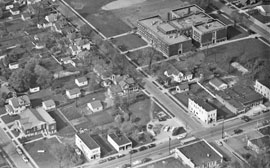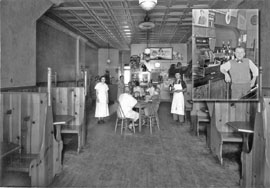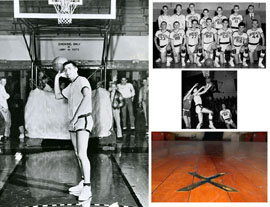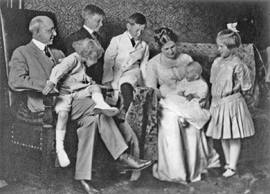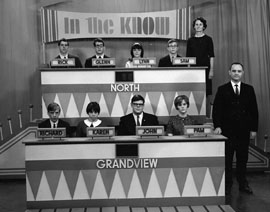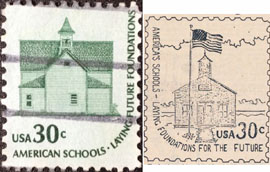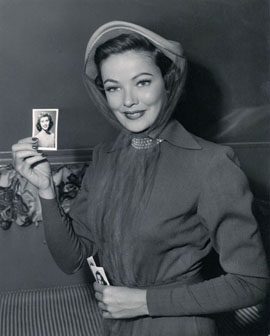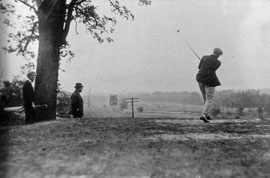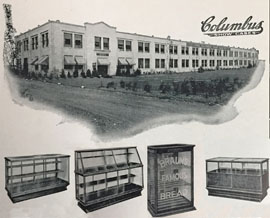George Linn graduated from Grandview High School in 1952, having excelled in 4 sports (baseball, football, golf, and basketball). It was his abilities in basketball that caught the attention of new University of Alabama coach Johnny Dee, who recruited several players from Ohio to play at the SEC school. Linn went on to achieve first-team All American honors in 1956, and was honored in January of this year as an Allstate SEC Legend. In 1955, in a game between Alabama and North Carolina, Linn gathered in a rebound as time expired in the first half, turned and fired the ball the length of the court, making the shot as the buzzer sounded. The 85 feet, 11 inches shot was for many years the longest in NCAA history. A brass marker was placed in the floor of the Alabama court to commemorate (shown in the lower right) the shot. In this photo, Linn reenacts the shot from the location it was launched (an Alabama assistant coach had run on to the court after the shot and scratched a mark in the floor where it was taken). The upper right photo shows senior captain Linn in the center (#99) with his Bob Dudley coached Grandview team, and the center inset photo shows him in action taking a shot in a game against Bexley in 1952. Linn also was an alternate on the 1956 gold-medal winning Olympic basketball team, and later that year was drafted to play for the Boston Celtics in the NBA.
One of the original homes on First Avenue in the 1920s, 1578 West First Avenue was purchased by Mr C.L "Whitey" Deyo in 1941. He opened his business as Deyo Funeral Home and started a tradition of personal funeral service to the Tri-Village area. In 1959 Mr Deyo was joined by Ivan L. Davis and the partnership of Deyo-Davis Funeral Home was formed. Mr. Davis is one of the oldest active licensed funeral directors and embalmers in the state of Ohio. After the death of Mr. Deyo in 1964, Mr. Davis took over the service to the community with the name remaining the same. Ivan was later joined by his son, Jeffery, who received his funeral director's license in 1980. With expansion to the original home on West First Avenue and added parking facilities the partnership continued its tradition of personal service to the families of the Tri-Village area. The property is now being sold, with plans for a residential complex to be built on the site.
The commercial and social focus of the Grandview Heights community switched from First Avenue to Grandview Avenue after the competition of the Grandview Bank Block in 1927. In close proximity there were three grocery stores, a bank, drug stores, a movie theatre, and a confectionary. The community gravitated to Grandview Avenue for shopping, community block parties, high school fraternity and sorority initiations, movie debuts and just "hanging out". Except for an intermittent decline in the late 1970’s to mid 1980’s this level of community activity has been constant, with a greater resurgence in the 1990's as a result of shops and restaurants that were added to the strip. This 1948 photograph depicts this activity as shoppers visit the stores in the Bank Block on a late October morning.
Mr. Julius F. Stone was an influential Columbus industrialist and entrepreneur who lived in Grandview Heights. His home at 1065 Westwood, which he and his family lived in until the mid-1940s, was razed to develop the current Stonegate Village homes. Stone spent his early years on a farm and completed only six years of formal education, but he gained broad culture and knowledge through extensive reading. In 1867, at age 12, he began work as a railroad telegrapher and continued to work on the railroad until 1880. He was involved in coal mining in Ohio, West Virginia, Illinois and Iowa until 1903. In 1900 he married Edna Andress, who graduated from Ohio State University. They had five children: Julius, George, Franz, Theodora, and Natalia, all shown in this 1910 photo. Julius Stone Jr. is credited with saving Key West from financial ruin in 1935, and George piloted the first plane to land at Don Scott Field in 1942. A colonel in the Civil Air Patrol, George died in a plane crash. Mr. Stone Sr. was the owner of Ohio Buggy Works and the Seagrave Co., turn of the century makers of Seagrave fire engines. He was a trustee of The Ohio State University and President of the OSU Research Foundation. He donated quite a sum of money to the University, endowing a fellowship in Biophysical research, helping finance the observatory on campus, and purchasing the first OSU cyclotron. In 1925 he donated Gibralter Island in Lake Erie near Put-In-Bay to OSU to establish what would become the Franz Theodore Stone Lab, in honor of his father. He was very active in conservation issues, and organized the first Colorado River expedition for sport in 1909. He died in 1947 at 92 years of age.
WBNS-TV in Columbus created the on-air program "In the Know" in 1966 as a high school trivia show that tested students' knowledge of math, science, history, culture, geography, art, and current events. The top four central Ohio teams competed at the end of each season for academic scholarships at the Ohio State University. Pictured is the 1967 Grandview Heights High School team. Included (left to right) are: Rick Kuhn, Karen Williams, John Kaumeyer, Pam Parker, and their advisor Mr. James Parker. Grandview’s most recent success on the show was in the 2001-2002 season, when they battled Bexley in the finals. Both teams were semi finalists the previous year. "In the Know" began at WBNS as a live production, and is one of the nation's longest-running broadcast shows that never went on hiatus. WOSU-TV has produced it the past 34 seasons.
A structure that was sometimes adjacent to turn-of-the-century homes in Grandview Heights and Marble Cliff was the water tower, or tank house, as it was sometimes known. This building provided storage for water that was used in the residence, and because of its height, provided the necessary pressure for adequate usage. The early water tanks were made of redwood, and later metal. The structure enclosures sometimes had space for storage, including carriages. Some even integrated living space for visitors or hired help. This left photo shows the tower in the rear of the Eugene Gray home (designed by Frank Packard) at 1080 Wyandotte Road as seen looking southeast from the back porch of the house. The structure at the left of the photo was the carriage house, and is now a separate home at 1082 Wyandotte. The top right photo was the tower on the property of the Urlin mansion, and the lower right photo was the tower of the John Price residence, which was located at Fifth Ave. and Dublin Rd. Both of these used windmills to pump water from wells or cisterns to the storage at the top of the tower.
Grandview community leader William T. Eaton and his wife Emma are shown here in 1916 in the front yard of their new home at 1413 Wyandotte Road, at the corner of Third Avenue and Wyandotte. Their son Ted was a well-known Grandview High School student personality, active in the Brotherhood of the Rook, and later becoming a prominent insurance man. In 1919 the Community Church in Grandview (later First Community Church) started a local newspaper, called the Community News, and Eaton became its first editor. After it was taken over by Curtis F. "Squire" Ricketts it was renamed the Tri-Village News. In the background of the photo is the home of William Carlon at 1392 Wyandotte. The curve in the street at Third and Wyandotte is apparent over Emma's shoulder.
The Tri-Village News reported in August of 1979 that a Grandview resident and school teacher had been selected as a contributor to the design of a U.S. postage stamp. Michael Weddle is known in the community as a popular, long-time teacher at Edison Elementary School, and also as a guide at the Ohio Statehouse. In 1978 Weddle submitted a drawing of a one-room schoolhouse (right, in photo) with the legend “America’s Schools - Laying Foundations fort the Future” as a suggested design for a stamp in the Americana Series. The postal service liked the idea, but chose a real school in North Dakota to be featured in the drawing; they kept Weddle’s suggested legend (nearly) intact. The 30-cent stamp (left, in photo) was issued in 1979. According to the T-VN article, both Weddle and the artist of the chosen school were invited to the stamp issuing ceremony in N.D.
This December 1948 photograph shows Miss Marvyth Bonham's Stevenson Elementary School first graders (left to right) Marcia Williams, Susan Greenidge, and Donnie Rhoades in front of their Christmas Party Bulletin Board. The students worked for the money to cover their party expenses by performing household chores. A tally of each student's chore and wages are listed on the board. Marcia earned 5 cents for doing dishes while Susan received 2 cents for setting the table. Donnie was paid 5 cents for preparing baked potatoes. Throughout her long career at both Edison and Stevenson Elementary schools, Miss Bonham meticulously compiled an extensive written and photographic record of her students' activities, projects, and accomplishments. The entire Bonham collection is now maintained by the Historical Society.
Twin Rivers Golf Course, originally called Municipal Golf Course, was an 18-hole course on the southeast side of Grandview that opened March 7, 1921. This was about the time the Aladdin Country Club in Marble Cliff was closing. It was bounded by Twin Rivers Drive on the east, Dublin Road to the south, and the rail road tracks to the north (to the right of the photo). The clubhouse (top inset) was located at 860 Dublin Road, just to the left of the lake in the photo. This Grandview landmark was eliminated by freeway construction in 1956. Joe Thomas (bottom inset) was a local golf legend and pro at Twin Rivers. He started as a caddy at Arlington Country Club, and at 17 was the first to hold a caddy pin at the Scioto Country Club when it was dedicated in 1916. When the Twin Rivers course closed he was asked by then Columbus Mayor James A. Rhodes to find a venue for another municipal course, and Joe founded the Raymond Memorial course on Trabue Road. He remained as golf-pro there until his retirement in 1968.
In March of 1913, a devastating flood destroyed much of Columbus' near west side and killed nearly 100 people. More would have died were it not for the efforts of citizens who helped rescue stranded people and animals. One group of these good samaritans was the Howell family of Broadview Avenue, who are shown here as they prepare their boats to help in this rescue effort. A notation on the photograph says "How many people was it we rescued - 423 1/2 wasn't it? You know we got one M.M.I. cadet." (The M.M. I. reference is assumed to be for the Miami Military Institute in Germantown, who sent some cadets to assist in the rescue efforts.) The Howell's stable and barn shown here were located behind their home at 1082 Broadview, and were accessible by a pass-through carriage house that was built under the front porch of the house.
Twenty seven years old Hollywood actress Gene Tierney is shown in this 1948 photograph, taken at the Tri-Village Photography Studio in Grandview. At that time it was owned by the Schreiks and was located at 1589 West Fifth near North Star. Tierney was in Columbus with Players Theater when she stopped in at the photo studio to visit the owner, who lived next door to her in LA when he was in the service. She volunteered to help select the 1948 Grandview Heights High School May queen from a group of candidate photos while she was there. Here she holds the photo of the senior that she chose, Mary Catherine Hager. The other candidates, comprising the court, were Diana Gonser, Nadys Lewis, Rita Lee and Barbara Stevens. Tierney started her career on Broadway, but was discovered by movie mogul Darryl Zanuck in 1940. He signed her to his studio, 20th Century Fox, and she went on to star as the leading actress in nearly 40 films during the next two decades. She earned an academy award nomination in 1945 for her role opposite Cornel Wilde in Leave Her to Heaven.
The Grandview Heights and Marble Cliff area saw its first newspaper in June of 1916, called the Northwest Community Paper. It gave way to a monthly magazine-style publication, called the Norwester, which was published from 1917 until 1922. After its demise, First Community Church began publishing The Community News from the basement of the Lincoln Road chapel. The paper was sold to new owners, who were not able to make a go of it, and in 1930 it became the Tri-Village News, with E.B. Taylor as publisher. The following year C.F. “Squire” Ricketts bought the paper and started production on West First Avenue in a building that would later be moved to become part of Stew Harrison’s restaurant. After a short time in offices in the Bank Block, the newspaper organized in 1949 as the Tri-Village Publishing Company and built its own building across the street at 1302 Grandview Avenue. They were at that location until October of 1980 when they moved to Old Henderson Road. This photo was taken of the Grandview building in the 1950s before it was expanded several times (the news offices were destroyed by a fire in 1969, but the presses were still functional and the paper continued to be delivered.) The company added The Upper Arlington News in 1954, and later merged with the owner of several newspapers in north Columbus, and eventually became the Suburban News.
A group of sportsmen prepare for a round of trap shooting, while another group awaits a turn, at the Columbus Gun Club (also known as the Arlington Gun Club.) This structure was designed in 1905 by J. Upton Gribben, a noted Columbus architect and Grandview resident, who was a former protege of prolific architect Frank Packard. It served as the center of social activity for prominent citizens of the area, as skeet shooting had become a national passion during this time.The Gun Club was located on the north side of Fifth Avenue between Arlington Avenue and Cambridge Blvd. until the Northwest Boulevard Company began the development of the Country Club District in 1915. The Country Club District was the first development in what would become Upper Arlington. At that time the Club moved to a new building on the north side of King Avenue at Andover. The Club was the site of the Grand American Handicap Trap Shoot in 1908, and attracted famous shooters like Annie Oakley (top inset) and John Philip Sousa (bottom inset). It is reported in the book History of Upper Arlington that an all wood motordrome, for use in racing motorcycles, was also located on the Gun Club property. The building (front view in upper left inset) was used as the field office for the King Thompson Northwest Boulevard Company after the club moved, and the Armstrong family, some of the earliest UA residents, lived in the second floor rooms.
Grandview girls are shown practicing their archery skills in this mid-1940s photo. The girls were part of the physical education class taught by teacher Emily Peterson. Peterson, or "Pete” as she was often called, arrived at Grandview High School in 1925 as the physical education teacher and girls athletic director. She had her B.S. in Physical Education from the University of Wisconsin and her M.A. from Columbia University, and her first teaching job brought the Bucyrus High School girls' basketball team a championship in 1925. At Grandview, her teams' winning records continued for four consecutive years, and she was recognized with a trophy for these consecutive wins. During the 1930's "Pete" introduced field hockey and other new sports to Grandview, while also developing strong intramural programs. She organized and started the Girls Athletic Association, was the supervisor of homecoming celebrations, and taught health and managed the adult education program. Emily Peterson is in the Hall of Fame of Grandview Heights High School.
A golfer tees off on the first fairway of the Arlington Country Club, just west of the clubhouse on the bluff overlooking the Scioto River and Dublin Pike (now Dublin Road) in Marble Cliff. In 1896 the Arlington Driving and Riding Club moved into the quarters designed for them by noted Columbus architect Frank Packard. The two-story clubhouse was on over four acres of land, and included a track and stable facilities for the riding club. It was due south of present-day No. 10 Arlington Place, and the clubhouse sat on the edge of the bluff facing the valley below. Until 1903 it was the area’s first golf course, originally consisting of four holes, two par threes and two par fours. An additional 12 acres were acquired after 1905 to accommodate a nine-hole golf course, and it was incorporated as the Arlington Country Club. In March of 1919, the Shriners of the Aladdin Temple purchased the property, which included almost 17 acres of grounds, the club house, a bowling house, locker and shower buildings, tennis courts and the nine hole golf course that spanned the railroad tracks on the west side of the Village of Marble Cliff. The first fairway crossed the tracks from the clubhouse toward Dublin Road. The second hole was down the hill and across the road. The eighth green was east of the road and the railroad tracks near the Frank Lindenberg home. After extensive remodeling and landscaping (with plans to enlarge the golf course to 18 holes, which were never realized) it reopened as the Aladdin Country Club, "a place for pleasure, entertainment and exercise" for its members. The club expanded its membership with golf as the major sport. The golf club remained in existence until 1925, and the clubhouse survived for some years, sometimes vacant, and sometimes as a private residence.
When the Hamlet of Marble Cliff was established in 1901, it included land west of the Olentangy River, between King and Fifth Avenue, that was earlier part of Sellsville. Early lore indicated that “gypsy” clans inhabited the woods there and often caused trouble at businesses along Fifth. In the early 1920s, W.F. Aschinger purchased property that fronted 500 feet of Fifth Avenue (862-882 W. 5th) that was part of those woods at one time, to build the factory of the Columbus Show Case Company (founded in 1895), which he acquired in 1914. The new factory was completed in 1923, and housed the company until it moved to the far west side in 1998. The Meridian Apartment complex now sits on the site - the road through the complex is named for Aschinger. The company manufactured a complete line of all plate glass and wood frame floor cases, wood frame counter cases, bakery display cases for both wholesale and retail bakers, sectional unit wall cases, plate glass set-on-top cases and glass window display sets for retail facilities. An early article described the Columbus Show Case building as follows: “It is one of the modern type of factory buildings that present a handsome architectural appearance. In construction and arrangement it has carried out the most modern ideas in industrial building, great windows affording a flood of light, and the building itself is always plenty of fresh air and light. Working conditions for employees are ideal, and arrangements permit not only perfect efficiency in operation, expeditious handling of each step in the manufacture, but also the advantage and welfare of the workers themselves. Many of the machines were specially made for the plant, and this is one of Ohio's industries that might profitably be studied for advanced lessons in shop practice.” The company, which was recently known as CSC Worldwide, closed in 2013.
